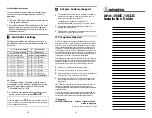
3
The Drivers for Windows
last part of the transmission does not trigger the 62 byte limit, this causes a delay in receiving the
data. As the consequence the application can not operate on the data very early.
Usually this is not a problem, but with certain serial protocols this can cause strange effects. So
a reduction to 1 ms is appropriate then, faster reactions are not possible. This is caused by the
protocol structure of USB, not by the serial port.
3.3.2.2 Serial Enumerator
In the lower right corner of the advanced options is a set of options
for different purposes.
This option is enabled by default. When the driver is started, Windows tries to detect hardware
attached to the serial port. There may be a mouse or a modem. Most often the attached device
is neither of that, so it is not a problem to disable this option. Further some devices permanently
send data to the Host, without special requests. Windows may falsely recognize such devices as
a serial mouse. This causes your pointer to randomly jump over the screen. Disabling the option
prevents this.
3.3.2.3 Serial Printer
When flow control like RTS/CTS stops data from being sent to the serial
port for a sufficient time, this will cause an error event for the application. However if the attached
serial device is a printer, sometimes this will halt for paper feed, especially for manual interaction.
This will cause the data flow to stop for a significant long time.
Enabling this option causes such errors never to be reported to the application. So printing will
never cause erroneous error messages.
3.3.2.4 Cancel if Power Off
Instead of a regular shut down the computer can be sent into sleep
or hibernate mode. In this situation neither the serial port nor the driver can perform any requests.
In rare situations this can cause problems.
Enabling this option dumps any open requests for driver or hardware, if the computer is powered
off by any Suspend state.
3.3.2.5 Event On Surprise Removal
Usually this option is disabled because software does not
use it. When it is enabled, application software can request to be notified if the hardware of the
serial port is removed from the system while it is in use. So instead of claiming a malfunction of
the attached serial device it can correctly report the removal of the port.
3.3.2.6 Set RTS On Close
Usually the signal RTS is disabled when the port gets closed. However
some kind of serial hardware may require a permanently active RTS for correct operation. Otherwise
there may be error messages when the port is opened again to use the device.
Enabling this option causes the RTS to stay active even when the application closes the serial
port.
June 2009
USB-COM PRO User Manual
17















































